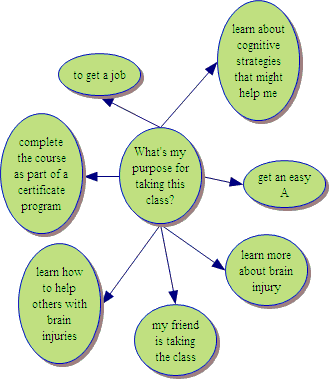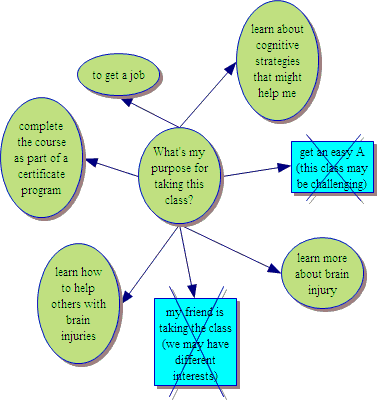In the Brainstorming—phase one article, we discussed how powerful this cognitive strategy is. You can use it to help you when you’re writing, making decisions, or solving a problem. That article also described the initial phase of brainstorming. During this phase, you generate as many ideas as possible about a designated topic without evaluating or editing them. The whole point is to let the ideas flow. In the example I gave, I used a concept-mapping program (Inspiration) to visually represent several ideas about my topic.
Brainstorming technique—phase two
Now, it’s time to introduce the second phase of brainstorming—elimination. Since you haven’t edited or evaluated your list of ideas yet, some ideas will be better than others. The elimination phase is designed to help you weed out the ideas that aren’t that great or aren’t very realistic. The goal is to end up with the best possible ideas you can come up with.
Here’s a fresh example of a brainstorm regarding why you might take a class related to brain injury:

As you can see, I have come up with several ideas as to why you might enroll in such a class:
- get a job
- learn how to help others with brain injuries
- learn about cognitive strategies that might help me
- get an easy A
- learn more about brain injury
- my friend is taking the class
- complete a certificate program
Once you have finished phase one of the brainstorming process, you should take the opportunity to evaluate the various ideas you identified. Some of the ideas may be great, some not so great, and some downright bad. Consider each idea carefully. Think about the following:
- how relevant the idea is to your purpose
- how realistic the idea is
- how involved the idea will be to implement
- how motivating the idea is
As I go into the elimination phase, I see that some reasons are better or more motivating than others. For instance, taking the class because a friend is taking the class may not be enough to keep me motivated, especially if the friend is the one who is interested in the topic. Another example might be that going into a class thinking that it is an easy A is not very motivating in terms of studying. What happens if the class actually ends up being good, but quite challenging?
Phase two of the brainstorming process involves evaluating the various ideas identified in phase one and eliminating those that are not appropriate. Don’t just cross them off; identify why that particular idea wasn’t a good one. The following image shows my original brainstorm along with the ideas I eliminated and the reasons I eliminated them.

In general, you don’t want to delete those items you eliminate. They are a good reminder as to what your original thinking was and why you decided those ideas weren’t appropriate at the time.
Making cognitive connections
As referenced above, the following things might play a role in the decision-making process involved in the elimination phase of the brainstorming process:
- how relevant the idea is to your purpose
- how realistic the idea is
- how involved the idea will be to implement
- how motivating the idea is
It should be somewhat obvious that the second phase of the brainstorming process requires several cognitive skills, including decision making and differentiating between relevant and irrelevant information. Let’s take a quick look at some of these cognitive skills and how they apply to brainstorming.
Relevant vs. irrelevant
Distinguishing between those ideas that are relevant or pertinent to the purpose of the brainstorm and those that are not as closely related can be difficult for individuals with cognitive challenges. For instance, some individuals may not want to eliminate any options from their brainstormed list because they just can’t decide whether the idea directly relates to the purpose or not (we’ll get to the idea of decision making in just a minute). It is never a bad idea to share your brainstorm with others to get a different take on the information identified during the initial phase.
Decision making
Decision making plays a significant role in determining which items should be eliminated. The process of decision making is often difficult for individuals with cognitive challenges. Some individuals may act impulsively and eliminate items that are actually valid. Others may not be able to decide which items are appropriate and which items aren’t. Crossing off the items to be eliminated and adding the reason for it being eliminated can help clarify the decision being made.
In conclusion
Brainstorming is a technique many of us already know, but it isn’t a strategy that comes to mind for most individuals dealing with cognitive challenges. My experience suggests that brainstorming can significantly help those with cognitive challenges in many aspects of their lives. The fact that it can be used in home, school, and work environments makes it a very practical strategy. For instance, one might apply the two-phase brainstorm process to many scenarios, such as:
- You have a free weekend and you want to come up with some fun things to do.
- You want to prepare for an upcoming exam by identifying some possible test items.
- Your therapist asks you to write a summary of the difficulties you have.
- Your boss requests ideas for increasing motivation among co-workers.
